Comprehensive Audit Report: Financial Analysis of DIPL Ltd
VerifiedAdded on 2020/03/04
|9
|2492
|68
Report
AI Summary
This report provides a comprehensive audit analysis of DIPL Ltd, covering various aspects of its financial performance and risk assessment. The report begins with an overview of analytical processes, including trend and ratio analysis, used to evaluate the company's financial statements. It then delves into the identification of inherent risks, such as those associated with the adoption of a new IT system and inaccurate treatment of accounts receivable, and their potential impact on the financial statements. Furthermore, the report addresses fraud risks related to the new IT system and revenue recognition processes. The report highlights the importance of internal controls, proper reconciliation procedures, and the auditor's role in identifying and mitigating these risks. The report emphasizes the need for corrective actions to ensure the accuracy and reliability of financial reporting, including the importance of auditors being familiar with the new system and the potential impact of management's decisions on the audit opinion.

AUDIT
Paraphrase This Document
Need a fresh take? Get an instant paraphrase of this document with our AI Paraphraser
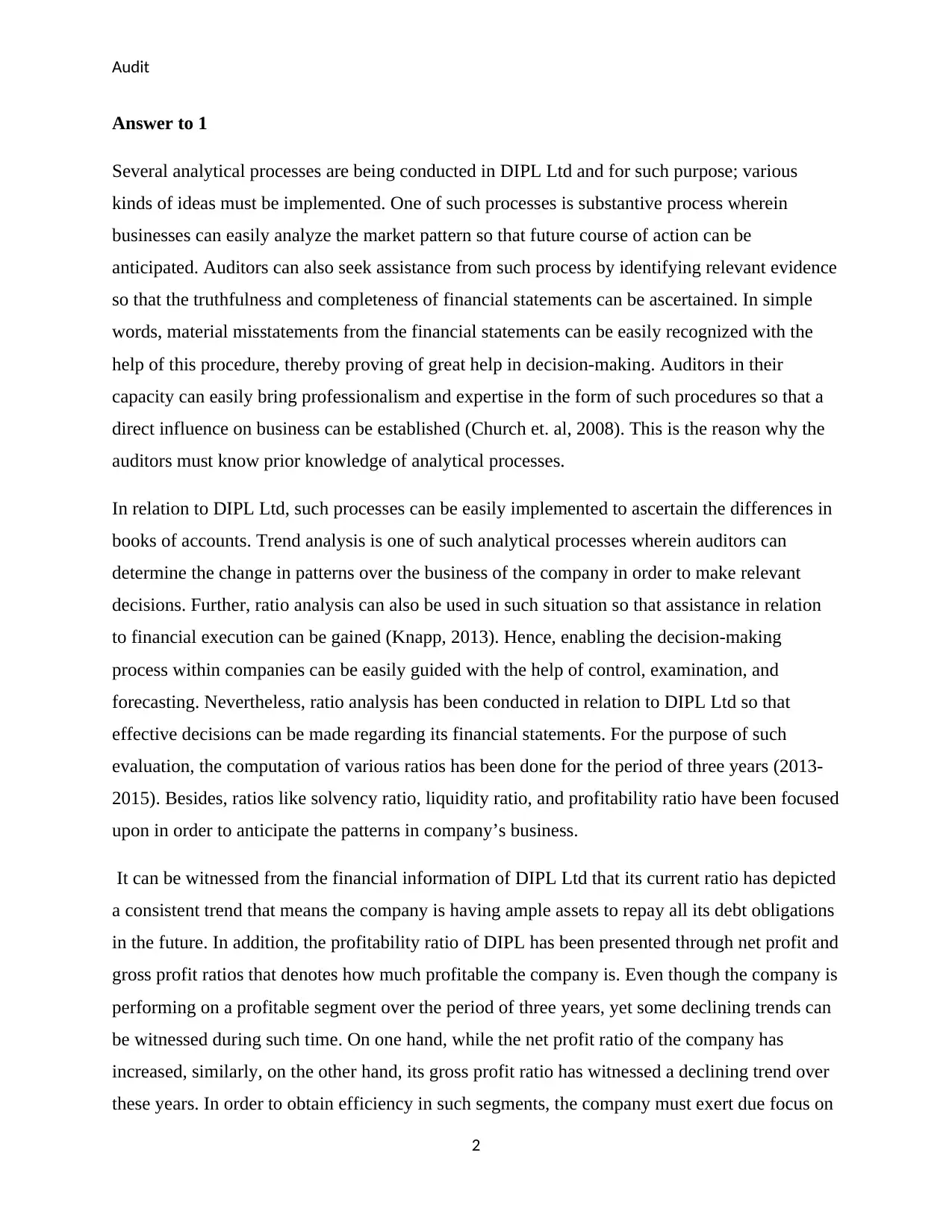
Audit
Answer to 1
Several analytical processes are being conducted in DIPL Ltd and for such purpose; various
kinds of ideas must be implemented. One of such processes is substantive process wherein
businesses can easily analyze the market pattern so that future course of action can be
anticipated. Auditors can also seek assistance from such process by identifying relevant evidence
so that the truthfulness and completeness of financial statements can be ascertained. In simple
words, material misstatements from the financial statements can be easily recognized with the
help of this procedure, thereby proving of great help in decision-making. Auditors in their
capacity can easily bring professionalism and expertise in the form of such procedures so that a
direct influence on business can be established (Church et. al, 2008). This is the reason why the
auditors must know prior knowledge of analytical processes.
In relation to DIPL Ltd, such processes can be easily implemented to ascertain the differences in
books of accounts. Trend analysis is one of such analytical processes wherein auditors can
determine the change in patterns over the business of the company in order to make relevant
decisions. Further, ratio analysis can also be used in such situation so that assistance in relation
to financial execution can be gained (Knapp, 2013). Hence, enabling the decision-making
process within companies can be easily guided with the help of control, examination, and
forecasting. Nevertheless, ratio analysis has been conducted in relation to DIPL Ltd so that
effective decisions can be made regarding its financial statements. For the purpose of such
evaluation, the computation of various ratios has been done for the period of three years (2013-
2015). Besides, ratios like solvency ratio, liquidity ratio, and profitability ratio have been focused
upon in order to anticipate the patterns in company’s business.
It can be witnessed from the financial information of DIPL Ltd that its current ratio has depicted
a consistent trend that means the company is having ample assets to repay all its debt obligations
in the future. In addition, the profitability ratio of DIPL has been presented through net profit and
gross profit ratios that denotes how much profitable the company is. Even though the company is
performing on a profitable segment over the period of three years, yet some declining trends can
be witnessed during such time. On one hand, while the net profit ratio of the company has
increased, similarly, on the other hand, its gross profit ratio has witnessed a declining trend over
these years. In order to obtain efficiency in such segments, the company must exert due focus on
2
Answer to 1
Several analytical processes are being conducted in DIPL Ltd and for such purpose; various
kinds of ideas must be implemented. One of such processes is substantive process wherein
businesses can easily analyze the market pattern so that future course of action can be
anticipated. Auditors can also seek assistance from such process by identifying relevant evidence
so that the truthfulness and completeness of financial statements can be ascertained. In simple
words, material misstatements from the financial statements can be easily recognized with the
help of this procedure, thereby proving of great help in decision-making. Auditors in their
capacity can easily bring professionalism and expertise in the form of such procedures so that a
direct influence on business can be established (Church et. al, 2008). This is the reason why the
auditors must know prior knowledge of analytical processes.
In relation to DIPL Ltd, such processes can be easily implemented to ascertain the differences in
books of accounts. Trend analysis is one of such analytical processes wherein auditors can
determine the change in patterns over the business of the company in order to make relevant
decisions. Further, ratio analysis can also be used in such situation so that assistance in relation
to financial execution can be gained (Knapp, 2013). Hence, enabling the decision-making
process within companies can be easily guided with the help of control, examination, and
forecasting. Nevertheless, ratio analysis has been conducted in relation to DIPL Ltd so that
effective decisions can be made regarding its financial statements. For the purpose of such
evaluation, the computation of various ratios has been done for the period of three years (2013-
2015). Besides, ratios like solvency ratio, liquidity ratio, and profitability ratio have been focused
upon in order to anticipate the patterns in company’s business.
It can be witnessed from the financial information of DIPL Ltd that its current ratio has depicted
a consistent trend that means the company is having ample assets to repay all its debt obligations
in the future. In addition, the profitability ratio of DIPL has been presented through net profit and
gross profit ratios that denotes how much profitable the company is. Even though the company is
performing on a profitable segment over the period of three years, yet some declining trends can
be witnessed during such time. On one hand, while the net profit ratio of the company has
increased, similarly, on the other hand, its gross profit ratio has witnessed a declining trend over
these years. In order to obtain efficiency in such segments, the company must exert due focus on
2
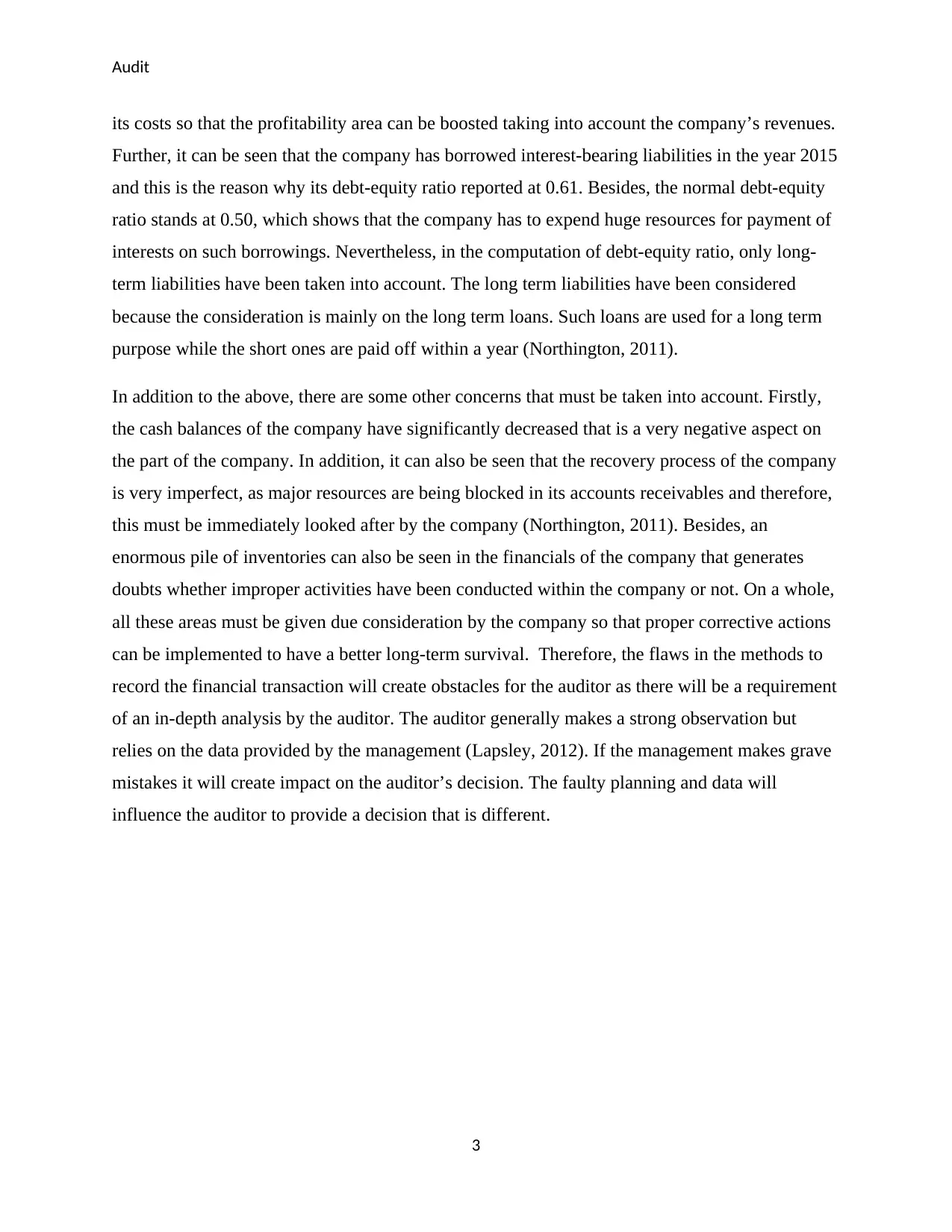
Audit
its costs so that the profitability area can be boosted taking into account the company’s revenues.
Further, it can be seen that the company has borrowed interest-bearing liabilities in the year 2015
and this is the reason why its debt-equity ratio reported at 0.61. Besides, the normal debt-equity
ratio stands at 0.50, which shows that the company has to expend huge resources for payment of
interests on such borrowings. Nevertheless, in the computation of debt-equity ratio, only long-
term liabilities have been taken into account. The long term liabilities have been considered
because the consideration is mainly on the long term loans. Such loans are used for a long term
purpose while the short ones are paid off within a year (Northington, 2011).
In addition to the above, there are some other concerns that must be taken into account. Firstly,
the cash balances of the company have significantly decreased that is a very negative aspect on
the part of the company. In addition, it can also be seen that the recovery process of the company
is very imperfect, as major resources are being blocked in its accounts receivables and therefore,
this must be immediately looked after by the company (Northington, 2011). Besides, an
enormous pile of inventories can also be seen in the financials of the company that generates
doubts whether improper activities have been conducted within the company or not. On a whole,
all these areas must be given due consideration by the company so that proper corrective actions
can be implemented to have a better long-term survival. Therefore, the flaws in the methods to
record the financial transaction will create obstacles for the auditor as there will be a requirement
of an in-depth analysis by the auditor. The auditor generally makes a strong observation but
relies on the data provided by the management (Lapsley, 2012). If the management makes grave
mistakes it will create impact on the auditor’s decision. The faulty planning and data will
influence the auditor to provide a decision that is different.
3
its costs so that the profitability area can be boosted taking into account the company’s revenues.
Further, it can be seen that the company has borrowed interest-bearing liabilities in the year 2015
and this is the reason why its debt-equity ratio reported at 0.61. Besides, the normal debt-equity
ratio stands at 0.50, which shows that the company has to expend huge resources for payment of
interests on such borrowings. Nevertheless, in the computation of debt-equity ratio, only long-
term liabilities have been taken into account. The long term liabilities have been considered
because the consideration is mainly on the long term loans. Such loans are used for a long term
purpose while the short ones are paid off within a year (Northington, 2011).
In addition to the above, there are some other concerns that must be taken into account. Firstly,
the cash balances of the company have significantly decreased that is a very negative aspect on
the part of the company. In addition, it can also be seen that the recovery process of the company
is very imperfect, as major resources are being blocked in its accounts receivables and therefore,
this must be immediately looked after by the company (Northington, 2011). Besides, an
enormous pile of inventories can also be seen in the financials of the company that generates
doubts whether improper activities have been conducted within the company or not. On a whole,
all these areas must be given due consideration by the company so that proper corrective actions
can be implemented to have a better long-term survival. Therefore, the flaws in the methods to
record the financial transaction will create obstacles for the auditor as there will be a requirement
of an in-depth analysis by the auditor. The auditor generally makes a strong observation but
relies on the data provided by the management (Lapsley, 2012). If the management makes grave
mistakes it will create impact on the auditor’s decision. The faulty planning and data will
influence the auditor to provide a decision that is different.
3
⊘ This is a preview!⊘
Do you want full access?
Subscribe today to unlock all pages.

Trusted by 1+ million students worldwide
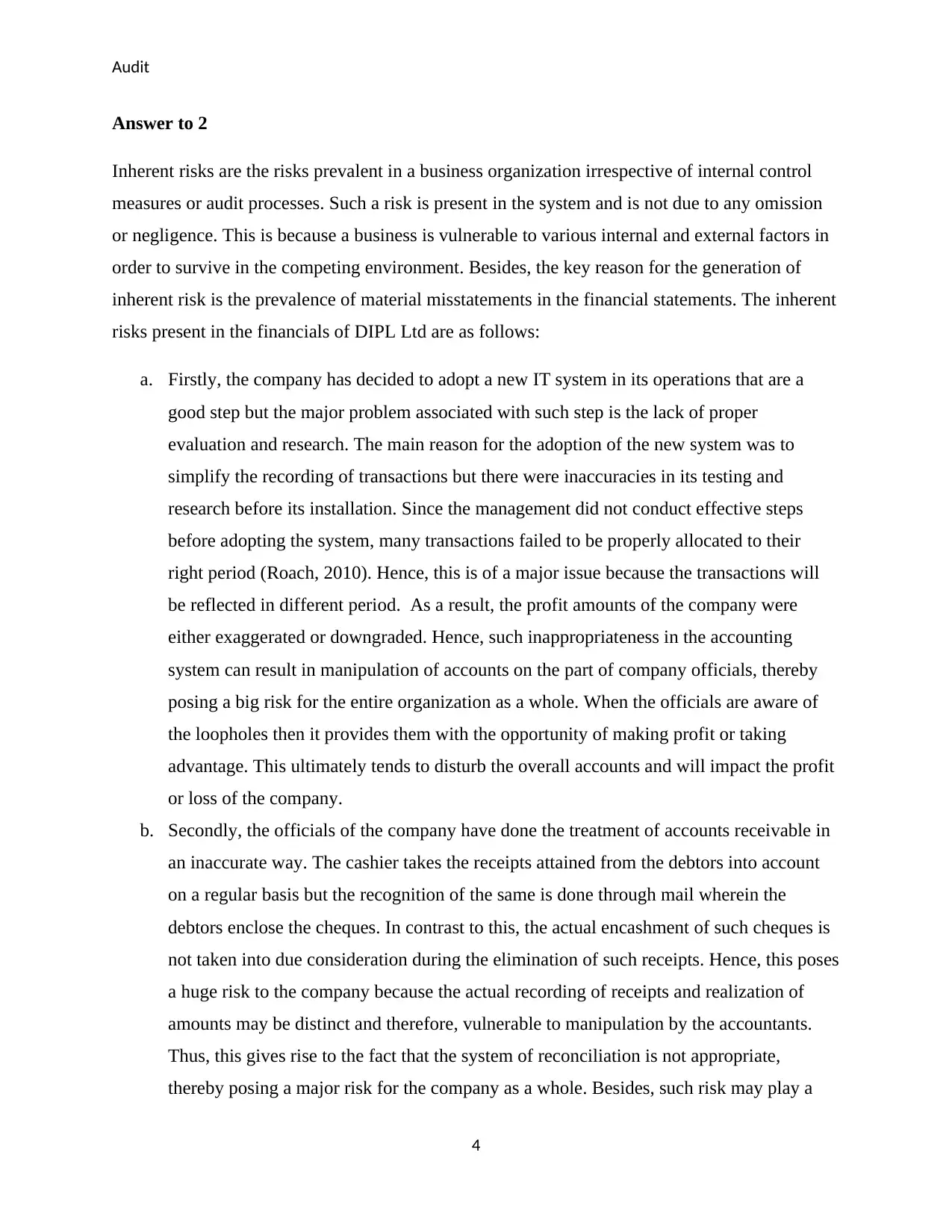
Audit
Answer to 2
Inherent risks are the risks prevalent in a business organization irrespective of internal control
measures or audit processes. Such a risk is present in the system and is not due to any omission
or negligence. This is because a business is vulnerable to various internal and external factors in
order to survive in the competing environment. Besides, the key reason for the generation of
inherent risk is the prevalence of material misstatements in the financial statements. The inherent
risks present in the financials of DIPL Ltd are as follows:
a. Firstly, the company has decided to adopt a new IT system in its operations that are a
good step but the major problem associated with such step is the lack of proper
evaluation and research. The main reason for the adoption of the new system was to
simplify the recording of transactions but there were inaccuracies in its testing and
research before its installation. Since the management did not conduct effective steps
before adopting the system, many transactions failed to be properly allocated to their
right period (Roach, 2010). Hence, this is of a major issue because the transactions will
be reflected in different period. As a result, the profit amounts of the company were
either exaggerated or downgraded. Hence, such inappropriateness in the accounting
system can result in manipulation of accounts on the part of company officials, thereby
posing a big risk for the entire organization as a whole. When the officials are aware of
the loopholes then it provides them with the opportunity of making profit or taking
advantage. This ultimately tends to disturb the overall accounts and will impact the profit
or loss of the company.
b. Secondly, the officials of the company have done the treatment of accounts receivable in
an inaccurate way. The cashier takes the receipts attained from the debtors into account
on a regular basis but the recognition of the same is done through mail wherein the
debtors enclose the cheques. In contrast to this, the actual encashment of such cheques is
not taken into due consideration during the elimination of such receipts. Hence, this poses
a huge risk to the company because the actual recording of receipts and realization of
amounts may be distinct and therefore, vulnerable to manipulation by the accountants.
Thus, this gives rise to the fact that the system of reconciliation is not appropriate,
thereby posing a major risk for the company as a whole. Besides, such risk may play a
4
Answer to 2
Inherent risks are the risks prevalent in a business organization irrespective of internal control
measures or audit processes. Such a risk is present in the system and is not due to any omission
or negligence. This is because a business is vulnerable to various internal and external factors in
order to survive in the competing environment. Besides, the key reason for the generation of
inherent risk is the prevalence of material misstatements in the financial statements. The inherent
risks present in the financials of DIPL Ltd are as follows:
a. Firstly, the company has decided to adopt a new IT system in its operations that are a
good step but the major problem associated with such step is the lack of proper
evaluation and research. The main reason for the adoption of the new system was to
simplify the recording of transactions but there were inaccuracies in its testing and
research before its installation. Since the management did not conduct effective steps
before adopting the system, many transactions failed to be properly allocated to their
right period (Roach, 2010). Hence, this is of a major issue because the transactions will
be reflected in different period. As a result, the profit amounts of the company were
either exaggerated or downgraded. Hence, such inappropriateness in the accounting
system can result in manipulation of accounts on the part of company officials, thereby
posing a big risk for the entire organization as a whole. When the officials are aware of
the loopholes then it provides them with the opportunity of making profit or taking
advantage. This ultimately tends to disturb the overall accounts and will impact the profit
or loss of the company.
b. Secondly, the officials of the company have done the treatment of accounts receivable in
an inaccurate way. The cashier takes the receipts attained from the debtors into account
on a regular basis but the recognition of the same is done through mail wherein the
debtors enclose the cheques. In contrast to this, the actual encashment of such cheques is
not taken into due consideration during the elimination of such receipts. Hence, this poses
a huge risk to the company because the actual recording of receipts and realization of
amounts may be distinct and therefore, vulnerable to manipulation by the accountants.
Thus, this gives rise to the fact that the system of reconciliation is not appropriate,
thereby posing a major risk for the company as a whole. Besides, such risk may play a
4
Paraphrase This Document
Need a fresh take? Get an instant paraphrase of this document with our AI Paraphraser
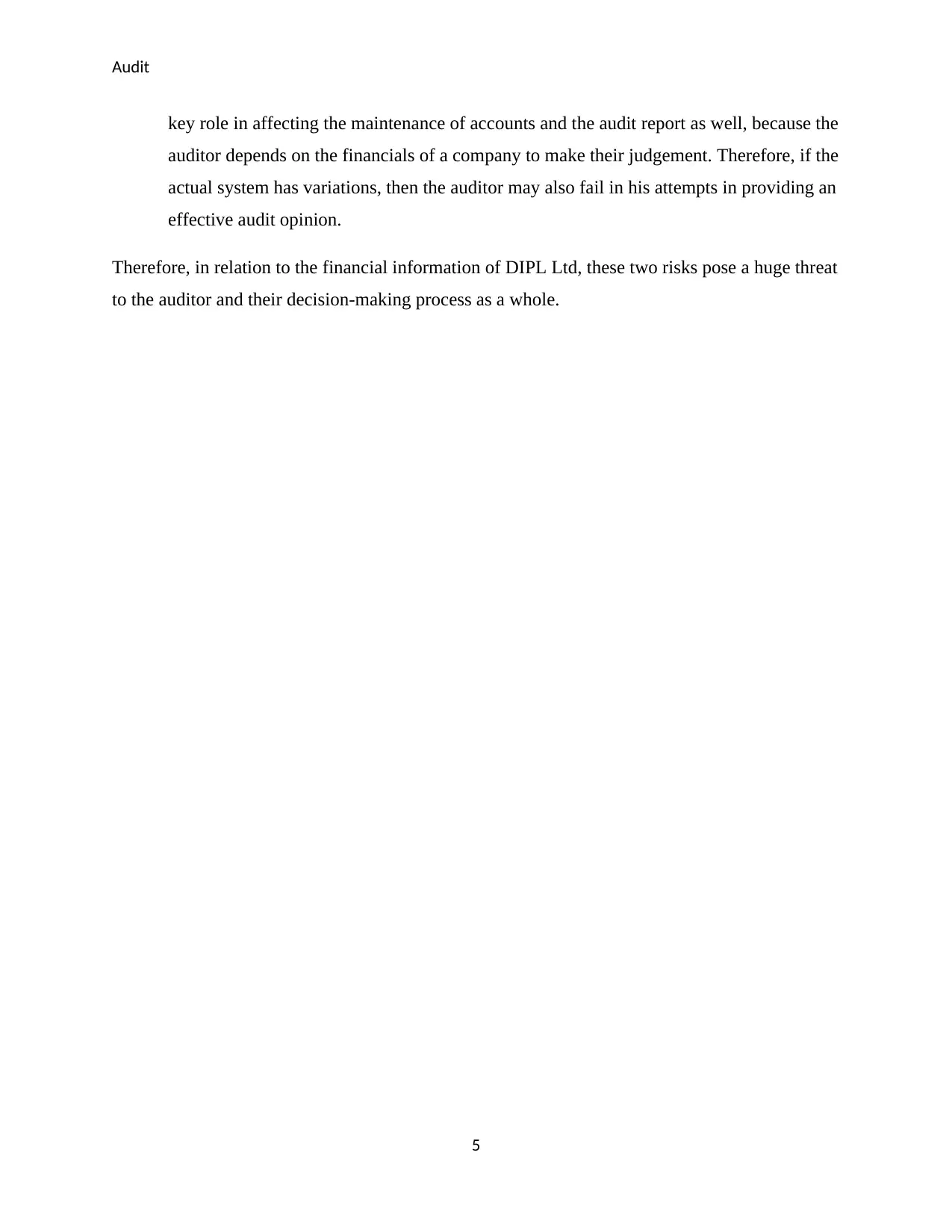
Audit
key role in affecting the maintenance of accounts and the audit report as well, because the
auditor depends on the financials of a company to make their judgement. Therefore, if the
actual system has variations, then the auditor may also fail in his attempts in providing an
effective audit opinion.
Therefore, in relation to the financial information of DIPL Ltd, these two risks pose a huge threat
to the auditor and their decision-making process as a whole.
5
key role in affecting the maintenance of accounts and the audit report as well, because the
auditor depends on the financials of a company to make their judgement. Therefore, if the
actual system has variations, then the auditor may also fail in his attempts in providing an
effective audit opinion.
Therefore, in relation to the financial information of DIPL Ltd, these two risks pose a huge threat
to the auditor and their decision-making process as a whole.
5
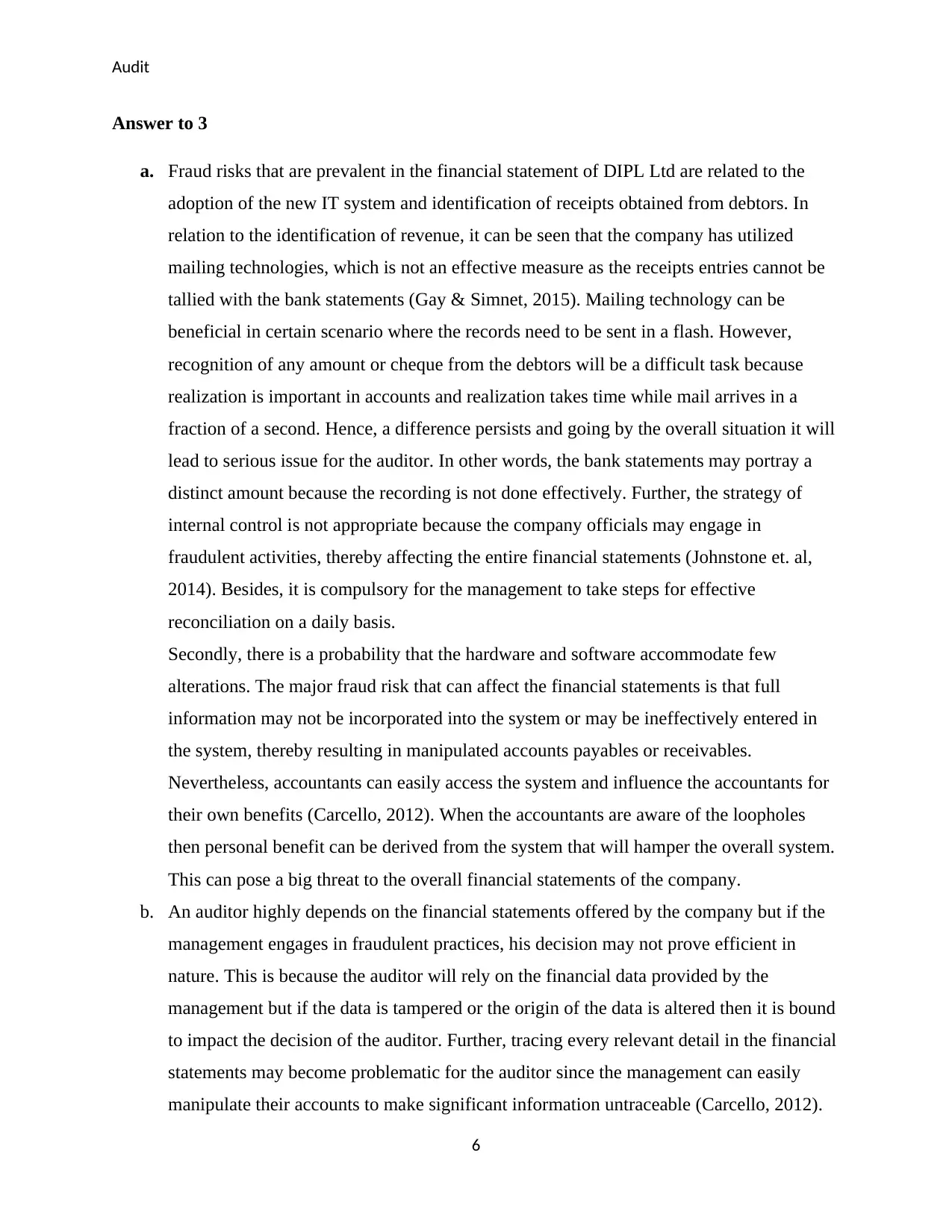
Audit
Answer to 3
a. Fraud risks that are prevalent in the financial statement of DIPL Ltd are related to the
adoption of the new IT system and identification of receipts obtained from debtors. In
relation to the identification of revenue, it can be seen that the company has utilized
mailing technologies, which is not an effective measure as the receipts entries cannot be
tallied with the bank statements (Gay & Simnet, 2015). Mailing technology can be
beneficial in certain scenario where the records need to be sent in a flash. However,
recognition of any amount or cheque from the debtors will be a difficult task because
realization is important in accounts and realization takes time while mail arrives in a
fraction of a second. Hence, a difference persists and going by the overall situation it will
lead to serious issue for the auditor. In other words, the bank statements may portray a
distinct amount because the recording is not done effectively. Further, the strategy of
internal control is not appropriate because the company officials may engage in
fraudulent activities, thereby affecting the entire financial statements (Johnstone et. al,
2014). Besides, it is compulsory for the management to take steps for effective
reconciliation on a daily basis.
Secondly, there is a probability that the hardware and software accommodate few
alterations. The major fraud risk that can affect the financial statements is that full
information may not be incorporated into the system or may be ineffectively entered in
the system, thereby resulting in manipulated accounts payables or receivables.
Nevertheless, accountants can easily access the system and influence the accountants for
their own benefits (Carcello, 2012). When the accountants are aware of the loopholes
then personal benefit can be derived from the system that will hamper the overall system.
This can pose a big threat to the overall financial statements of the company.
b. An auditor highly depends on the financial statements offered by the company but if the
management engages in fraudulent practices, his decision may not prove efficient in
nature. This is because the auditor will rely on the financial data provided by the
management but if the data is tampered or the origin of the data is altered then it is bound
to impact the decision of the auditor. Further, tracing every relevant detail in the financial
statements may become problematic for the auditor since the management can easily
manipulate their accounts to make significant information untraceable (Carcello, 2012).
6
Answer to 3
a. Fraud risks that are prevalent in the financial statement of DIPL Ltd are related to the
adoption of the new IT system and identification of receipts obtained from debtors. In
relation to the identification of revenue, it can be seen that the company has utilized
mailing technologies, which is not an effective measure as the receipts entries cannot be
tallied with the bank statements (Gay & Simnet, 2015). Mailing technology can be
beneficial in certain scenario where the records need to be sent in a flash. However,
recognition of any amount or cheque from the debtors will be a difficult task because
realization is important in accounts and realization takes time while mail arrives in a
fraction of a second. Hence, a difference persists and going by the overall situation it will
lead to serious issue for the auditor. In other words, the bank statements may portray a
distinct amount because the recording is not done effectively. Further, the strategy of
internal control is not appropriate because the company officials may engage in
fraudulent activities, thereby affecting the entire financial statements (Johnstone et. al,
2014). Besides, it is compulsory for the management to take steps for effective
reconciliation on a daily basis.
Secondly, there is a probability that the hardware and software accommodate few
alterations. The major fraud risk that can affect the financial statements is that full
information may not be incorporated into the system or may be ineffectively entered in
the system, thereby resulting in manipulated accounts payables or receivables.
Nevertheless, accountants can easily access the system and influence the accountants for
their own benefits (Carcello, 2012). When the accountants are aware of the loopholes
then personal benefit can be derived from the system that will hamper the overall system.
This can pose a big threat to the overall financial statements of the company.
b. An auditor highly depends on the financial statements offered by the company but if the
management engages in fraudulent practices, his decision may not prove efficient in
nature. This is because the auditor will rely on the financial data provided by the
management but if the data is tampered or the origin of the data is altered then it is bound
to impact the decision of the auditor. Further, tracing every relevant detail in the financial
statements may become problematic for the auditor since the management can easily
manipulate their accounts to make significant information untraceable (Carcello, 2012).
6
⊘ This is a preview!⊘
Do you want full access?
Subscribe today to unlock all pages.

Trusted by 1+ million students worldwide
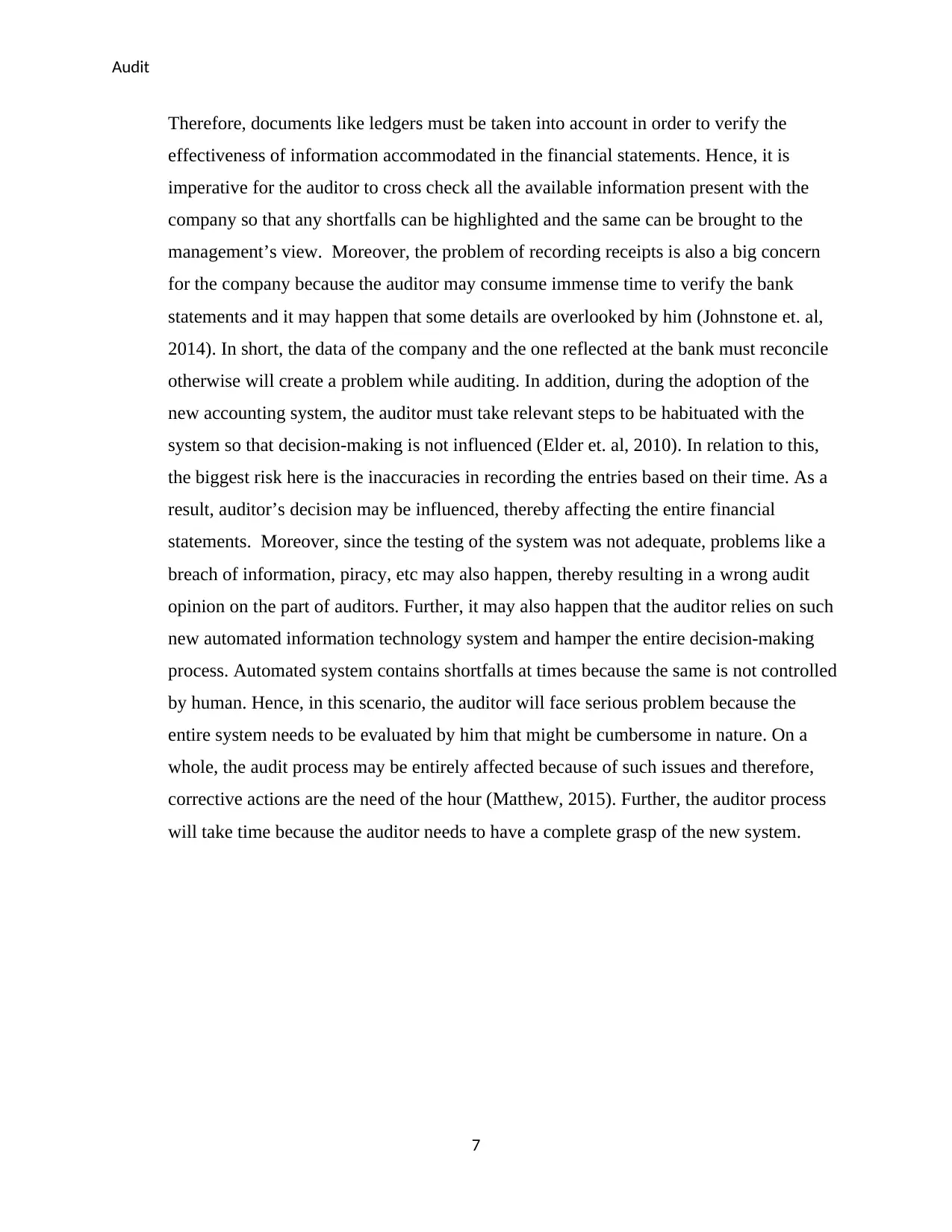
Audit
Therefore, documents like ledgers must be taken into account in order to verify the
effectiveness of information accommodated in the financial statements. Hence, it is
imperative for the auditor to cross check all the available information present with the
company so that any shortfalls can be highlighted and the same can be brought to the
management’s view. Moreover, the problem of recording receipts is also a big concern
for the company because the auditor may consume immense time to verify the bank
statements and it may happen that some details are overlooked by him (Johnstone et. al,
2014). In short, the data of the company and the one reflected at the bank must reconcile
otherwise will create a problem while auditing. In addition, during the adoption of the
new accounting system, the auditor must take relevant steps to be habituated with the
system so that decision-making is not influenced (Elder et. al, 2010). In relation to this,
the biggest risk here is the inaccuracies in recording the entries based on their time. As a
result, auditor’s decision may be influenced, thereby affecting the entire financial
statements. Moreover, since the testing of the system was not adequate, problems like a
breach of information, piracy, etc may also happen, thereby resulting in a wrong audit
opinion on the part of auditors. Further, it may also happen that the auditor relies on such
new automated information technology system and hamper the entire decision-making
process. Automated system contains shortfalls at times because the same is not controlled
by human. Hence, in this scenario, the auditor will face serious problem because the
entire system needs to be evaluated by him that might be cumbersome in nature. On a
whole, the audit process may be entirely affected because of such issues and therefore,
corrective actions are the need of the hour (Matthew, 2015). Further, the auditor process
will take time because the auditor needs to have a complete grasp of the new system.
7
Therefore, documents like ledgers must be taken into account in order to verify the
effectiveness of information accommodated in the financial statements. Hence, it is
imperative for the auditor to cross check all the available information present with the
company so that any shortfalls can be highlighted and the same can be brought to the
management’s view. Moreover, the problem of recording receipts is also a big concern
for the company because the auditor may consume immense time to verify the bank
statements and it may happen that some details are overlooked by him (Johnstone et. al,
2014). In short, the data of the company and the one reflected at the bank must reconcile
otherwise will create a problem while auditing. In addition, during the adoption of the
new accounting system, the auditor must take relevant steps to be habituated with the
system so that decision-making is not influenced (Elder et. al, 2010). In relation to this,
the biggest risk here is the inaccuracies in recording the entries based on their time. As a
result, auditor’s decision may be influenced, thereby affecting the entire financial
statements. Moreover, since the testing of the system was not adequate, problems like a
breach of information, piracy, etc may also happen, thereby resulting in a wrong audit
opinion on the part of auditors. Further, it may also happen that the auditor relies on such
new automated information technology system and hamper the entire decision-making
process. Automated system contains shortfalls at times because the same is not controlled
by human. Hence, in this scenario, the auditor will face serious problem because the
entire system needs to be evaluated by him that might be cumbersome in nature. On a
whole, the audit process may be entirely affected because of such issues and therefore,
corrective actions are the need of the hour (Matthew, 2015). Further, the auditor process
will take time because the auditor needs to have a complete grasp of the new system.
7
Paraphrase This Document
Need a fresh take? Get an instant paraphrase of this document with our AI Paraphraser
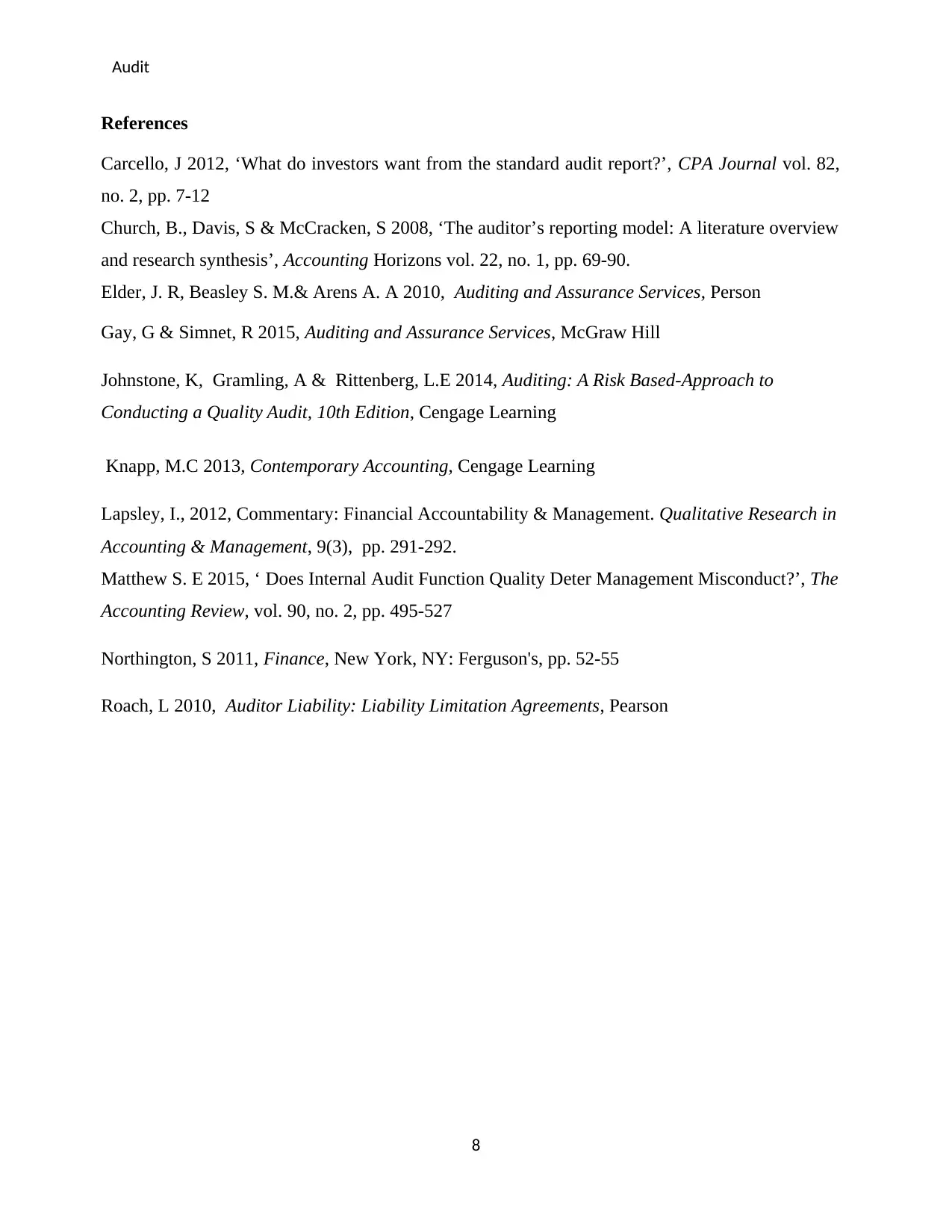
Audit
References
Carcello, J 2012, ‘What do investors want from the standard audit report?’, CPA Journal vol. 82,
no. 2, pp. 7-12
Church, B., Davis, S & McCracken, S 2008, ‘The auditor’s reporting model: A literature overview
and research synthesis’, Accounting Horizons vol. 22, no. 1, pp. 69-90.
Elder, J. R, Beasley S. M.& Arens A. A 2010, Auditing and Assurance Services, Person
Gay, G & Simnet, R 2015, Auditing and Assurance Services, McGraw Hill
Johnstone, K, Gramling, A & Rittenberg, L.E 2014, Auditing: A Risk Based-Approach to
Conducting a Quality Audit, 10th Edition, Cengage Learning
Knapp, M.C 2013, Contemporary Accounting, Cengage Learning
Lapsley, I., 2012, Commentary: Financial Accountability & Management. Qualitative Research in
Accounting & Management, 9(3), pp. 291-292.
Matthew S. E 2015, ‘ Does Internal Audit Function Quality Deter Management Misconduct?’, The
Accounting Review, vol. 90, no. 2, pp. 495-527
Northington, S 2011, Finance, New York, NY: Ferguson's, pp. 52-55
Roach, L 2010, Auditor Liability: Liability Limitation Agreements, Pearson
8
References
Carcello, J 2012, ‘What do investors want from the standard audit report?’, CPA Journal vol. 82,
no. 2, pp. 7-12
Church, B., Davis, S & McCracken, S 2008, ‘The auditor’s reporting model: A literature overview
and research synthesis’, Accounting Horizons vol. 22, no. 1, pp. 69-90.
Elder, J. R, Beasley S. M.& Arens A. A 2010, Auditing and Assurance Services, Person
Gay, G & Simnet, R 2015, Auditing and Assurance Services, McGraw Hill
Johnstone, K, Gramling, A & Rittenberg, L.E 2014, Auditing: A Risk Based-Approach to
Conducting a Quality Audit, 10th Edition, Cengage Learning
Knapp, M.C 2013, Contemporary Accounting, Cengage Learning
Lapsley, I., 2012, Commentary: Financial Accountability & Management. Qualitative Research in
Accounting & Management, 9(3), pp. 291-292.
Matthew S. E 2015, ‘ Does Internal Audit Function Quality Deter Management Misconduct?’, The
Accounting Review, vol. 90, no. 2, pp. 495-527
Northington, S 2011, Finance, New York, NY: Ferguson's, pp. 52-55
Roach, L 2010, Auditor Liability: Liability Limitation Agreements, Pearson
8
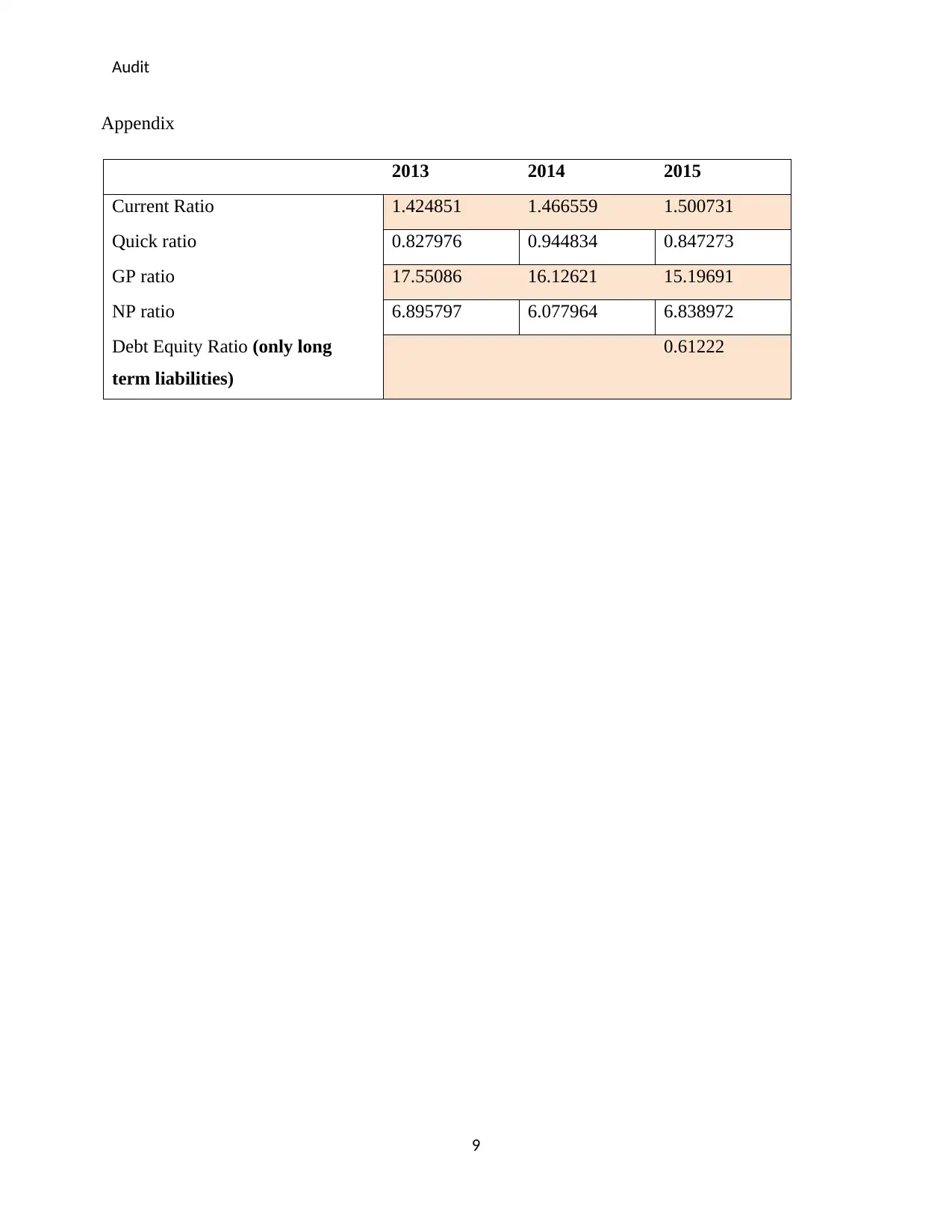
Audit
Appendix
2013 2014 2015
Current Ratio 1.424851 1.466559 1.500731
Quick ratio 0.827976 0.944834 0.847273
GP ratio 17.55086 16.12621 15.19691
NP ratio 6.895797 6.077964 6.838972
Debt Equity Ratio (only long
term liabilities)
0.61222
9
Appendix
2013 2014 2015
Current Ratio 1.424851 1.466559 1.500731
Quick ratio 0.827976 0.944834 0.847273
GP ratio 17.55086 16.12621 15.19691
NP ratio 6.895797 6.077964 6.838972
Debt Equity Ratio (only long
term liabilities)
0.61222
9
⊘ This is a preview!⊘
Do you want full access?
Subscribe today to unlock all pages.

Trusted by 1+ million students worldwide
1 out of 9
Related Documents
Your All-in-One AI-Powered Toolkit for Academic Success.
+13062052269
info@desklib.com
Available 24*7 on WhatsApp / Email
![[object Object]](/_next/static/media/star-bottom.7253800d.svg)
Unlock your academic potential
Copyright © 2020–2025 A2Z Services. All Rights Reserved. Developed and managed by ZUCOL.





